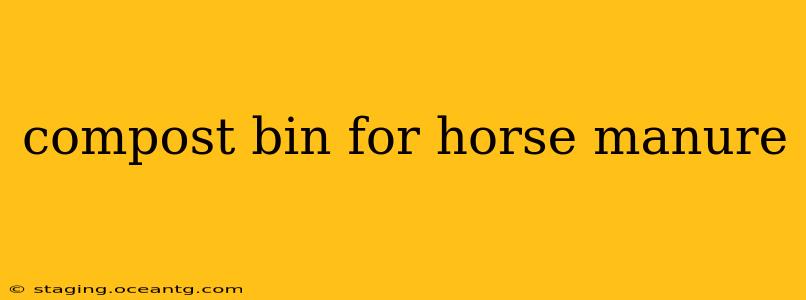Horse manure is a fantastic addition to your compost pile, offering rich nutrients for your garden. However, composting horse manure requires a slightly different approach than other materials due to its unique characteristics. This guide provides everything you need to know about creating a successful compost bin for horse manure.
What Makes Composting Horse Manure Different?
Horse manure differs from other animal manures in several key aspects:
-
Higher Nitrogen Content: Horse manure is relatively high in nitrogen, a crucial nutrient for plant growth. However, excessive nitrogen can lead to "burning" plants if not properly balanced. This necessitates careful management of the carbon-to-nitrogen ratio in your compost.
-
Weed Seeds: Horse manure often contains weed seeds, which can become a problem if not properly composted. The heat generated during the composting process is key to killing these seeds.
-
Parasite Risk: Depending on the horse's health, manure may contain parasite eggs or larvae. Proper composting, reaching high temperatures for an extended period, is essential for eliminating these risks.
How to Build a Compost Bin for Horse Manure
Choosing the right compost bin is crucial for successful composting. You have several options:
-
Three-Bin System: This is ideal for managing horse manure effectively. One bin for fresh manure, one for active composting, and one for finished compost. This system allows for a staggered approach, ensuring a continuous supply of compost.
-
Rotating Compost Bin: This design allows for easy turning of the compost, crucial for aeration and maintaining optimal temperatures.
-
Simple Pile: For smaller amounts of manure, a simple pile built against a wall or fence can be sufficient, provided you ensure proper aeration and turning. However, this approach can lead to odor issues if not managed correctly.
Regardless of the bin type, ensure adequate ventilation through gaps or openings in the sides and bottom.
What to Add to Your Horse Manure Compost Bin?
To create a well-balanced compost, you need to add “brown” materials (carbon-rich) to offset the high nitrogen content of horse manure. Excellent brown materials include:
- Straw: A readily available and effective carbon source.
- Wood chips: Provide excellent structure and carbon.
- Dried leaves: Abundant in autumn and provide valuable nutrients.
- Sawdust: Avoid treated lumber sawdust as it can be toxic to plants.
The ideal carbon-to-nitrogen ratio is around 30:1. However, precise measurement isn't crucial; a visual estimate aiming for a mix of brown and green materials works well.
How Long Does It Take to Compost Horse Manure?
The composting time depends on various factors, including bin type, ambient temperature, and moisture level. Under ideal conditions, horse manure compost can be ready in 6-12 months. Turning the compost regularly speeds up the process.
How to Tell if Your Horse Manure Compost is Ready?
Finished compost will be dark brown, crumbly, and have an earthy smell. It will also be relatively free of recognizable plant material or horse manure.
Can I Use Horse Manure Compost Directly in My Garden?
Yes, but use it sparingly, especially for young plants or seedlings. It's best to mix it with existing garden soil to prevent burning. Allowing the compost to age further enhances its safety and effectiveness.
What About Fly Control When Composting Horse Manure?
Horse manure attracts flies. To mitigate this:
- Regular Turning: Turning the compost reduces fly breeding sites.
- Covering: Partially covering the bin with a tarp or mesh can limit access.
- Attractants: Consider using fly traps specifically designed for manure composting.
Is Horse Manure Compost Safe for My Garden?
Yes, when properly composted, horse manure provides valuable nutrients for your plants. However, using raw or improperly composted manure poses risks of introducing weed seeds, pathogens, and parasites. Therefore, proper composting is crucial for safety.
This comprehensive guide helps ensure the success of your horse manure composting venture. Remember, patience and diligent management are key to creating nutrient-rich compost for your garden.
